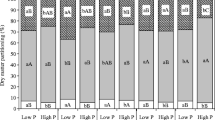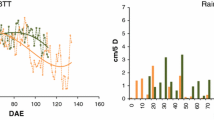Abstract
Partitioning patterns of14C labeled assimilates were studied to determine their relationship to dry matter accumulation and distribution in four potato clones (Desiree, DTO-28, LT-1 and Russet Burbank). Plants placed in growth chambers at 35/25 C day/night temperature and 12-hour photo-period two weeks after tuber initiation were compared with plants grown continuously at 25/12 C. Two weeks after temperature treatments were begun, the most recently expanded leaf was labeled with14CO2 for 30 minutes, and plants were harvested 20 hours or 15 days later. High temperature reduced total dry matter production and altered dry matter distribution in favor of vines at the expense of tubers. Partitioning of14C assimilates generally followed the pattern of dry matter distribution. Potato clones exhibited variation in14C assimilate export from labeled leaves and in partitioning to vines and tubers. Assimilate partitioning to tubers was not consistently higher in clones considered heat tolerant.
Compendio
Se estudiaron las formas de distribución de los productos de la fotosíntesis marcados con14C para determinar su relación con la acumulación de materia seca y su distribución en cuatro clones de papa (Desirée, DTO28, LT-1 y Russet Burbank). Se compararon plantas colocadas en cámaras de crecimiento a 35/25 C de temperaturas diurna/nocturna y 12 horas de fotoperiodo dos semanas después del inicio de la tuberización, con plantas en crecimiento continuo a 25/12 C. Dos semanas después de iniciarse los tratamientos térmicos, se marcó la hoja más recientemente expandida con14CO2 por 30 minutos y se cosecharon las plantas 20 horas o 15 días más tarde. La temperatura alta redujo la productión total de materia seca y alteró la distribución de la misma en favor del follaje a expensas de los tubérculos. La distribución de los productos de la fotosíntesis marcados con14C siguió generalmente la forma de distribución de la materia seca. Los clones de papa exhibieron variación en la exportación de los productos14C asimilados de las hojas marcadas y en la distribución de éstos en el follaje y en los tubérculos. La distribución de los productos asimilados en los tubérculos no fue consistentemente mayor en los clones considerados como resistentes al calor.
Similar content being viewed by others
Literature Cited
Basu, P.S. and J.S. Minhas. 1991. Heat tolerance and assimilate transport in differ ent potato genotypes. J Exp Bot 42: 861–866.
Ben Khedher, M. and E.E. Ewing. 1985. Growth analysis of eleven potato cultivars grown in the greenhouse under long photoperiods with and without heat stress. Am Potato J 62: 537–554.
Burton, W.G. 1972. The response of potato plant and tuber to temperature.In: Crop Processes in Controlled Environments. A.E. Rees, K.L. Cockhull, D.W. Hand and R.G. Hurd (Eds). Academic Press, New York. pp. 217–233.
Dinar, M. and J. Rudich. 1985. Effect of heat stress on assimilate partitioning in tomato. Ann Bot 56: 239–248.
Ewing, E.E. 1981. Heat stress and the tuberization stimulus. Am Potato J 58: 31–49.
Gawronska, H., R.B. Dwelle, J.J. Pavek and P. Rowe. 1984. Partitioning of photoas simulates by four potato clones. Crop Sci 24: 1031–1036.
Gawronska, H. and R.B. Dwelle. 1989. Partitioning of photoassimulates by potato plants (Solanum tuberosum L.) as influenced by irradiance. I. Partitioning patterns in cultivar Russet Burbank grown under high and low irradiance. Am Potato J 66: 201–213.
Krauss, A. and H. Marschner. 1984. Growth rate and carbohydrate metabolism of potato tubers exposed to high temperatures. Potato Res 27: 297–303.
Levy, D. 1985. The response of potato to a single transient heat or drought stress imposed at different stages of tuber growth. Potato Res 28: 415–424.
Levy, D. 1986. Genotypic variation in the response of potatoes (Solanum tuberosum L.) to high ambient temperatures and water deficit. Field Crops Res 15: 85–96.
Marinus, J. and K.B. A. Bodlaender. 1975. Response of some potato varieties to tem perature. Potato Res18: 189–204.
Marshall, H.G. 1982. Breeding for tolerance to heat and cold.In: Breeding Plants for Less Favorable Environments. M.N. Christiansen and C.F. Lewis (Eds.). Wiley and Sons, New York, pp. 13–15.
Mendoza, H.A. and R.N. Estrada. 1979. Breeding potatoes for tolerance to stress: heat and frost.In: Stress Physiology in Crop Plants. H. Mussell and R.C. Staples (Eds.). Wiley and Sons, New York. pp. 227–262.
Menzel, C.M. 1985. Tuberization in potato at high temperatures. Interaction between temperature and irradiance. Ann Bot 55: 35–39.
Mohabir, G. and P. John. 1988. Effect of temperature on starch synthesis in potato tuber tissue and in amyloplasts. Plant Physiol 88: 1222–1228.
Morpurgo, R. and R. Ortiz. 1988. Morphological variation of the potato (Solanum spp.) under contrasting environments. Env and Exp Bot 28: 165–169.
Munns, R. and C.J. Pearson. 1974. Effect of water deficit on translocation of carbo hydrate inSolanum tuberosum. Aust J Plant Physiol 1: 529–537.
Nagarajan, S. and K.C. Bansal. 1990. Growth and distribution of dry matter in heat tolerant and a susceptible potato cultivar under normal and high temperature. J Agron Crop Sci 165: 306–311.
Oparka, K.J., H.V. Davies and D.A.M. Prior. 1987. The influence of applied nitro gen on export and partitioning of current assimilate by field-grown potato plants. Ann Bot 59: 311–323.
Randeni, G. and K. Caesar. 1986. Effect of soil temperature on the carbohydrate status in the potato plant (S. tuberosum L.). J Agron Crop Sci156: 217–224.
Sattlemacher, B. 1983. A rapid seedling test for adaptation to high temperatures. Potato Res 26: 133–138.
Susnoschi, M., B. Costelloe, Y. Lifshitz, H.C. Lee and Y. Roseman. 1987. Arma: A potato cultivar resistant to heat stress. Am Potato J 64: 191–196.
Westermann, D.T. and G.E. Kleinkopf. 1985. Nitrogen requirements of potatoes. Agron J 77: 616–621.
Wolf, S., A. Marani and J. Rudich. 1990. Effects of temperature and photoperiod on assimilate partitioning in potato plants. Ann Bot 66: 513–520.
Wolf, S., A. Marani and J. Rudich. 1991. Effect of temperature on carbohydrate metab olism in potato plants. J Exp Bot 42: 619–625.
Author information
Authors and Affiliations
Additional information
Supported in part by the Idaho Potato Commission and by USDA/BARD Grant No. US-0994-85R. Idaho Agricultural Experiment Station Research Paper No. 91716.
Rights and permissions
About this article
Cite this article
Gawronska, H., Thornton, M.K. & Dwelle, R.B. Influence of heat stress on dry matter production and photo-assimilate partitioning by four potato clones. American Potato Journal 69, 653–665 (1992). https://doi.org/10.1007/BF02852678
Accepted:
Issue Date:
DOI: https://doi.org/10.1007/BF02852678




